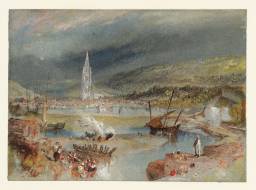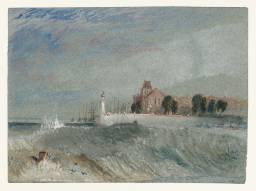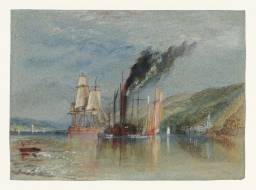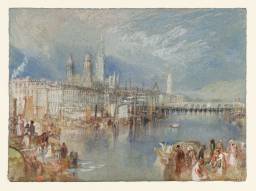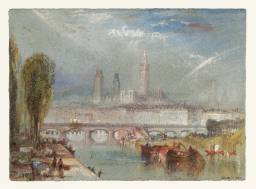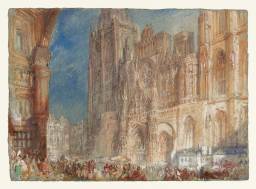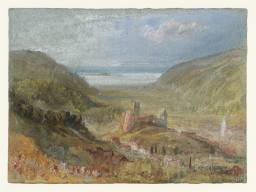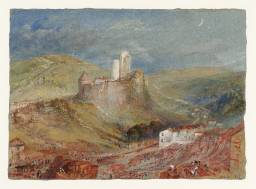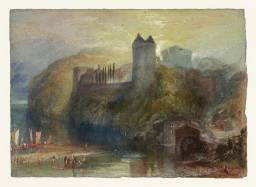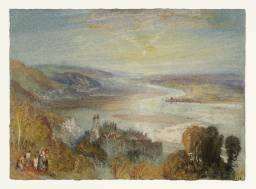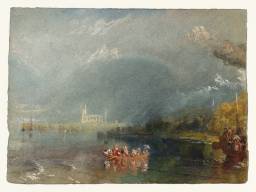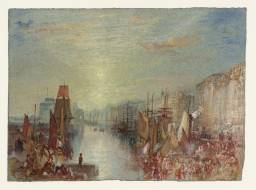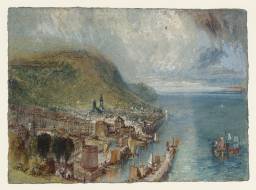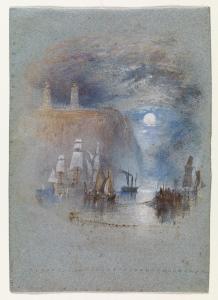Turner Bequest CCLIX 102–111, 128, 130, 131, 133–136
References
This subsection of watercolours comprises seventeen works of views along the River Seine, in northern France. Broadly, the locations covered stretch from the city of Le Havre on the Seine Estuary, inland and eastwards, to the city of Rouen. Turner produced them to be made into engravings to illustrate the volume, Turner’s Annual Tour – Wanderings by the Seine, published in 1834. A further three watercolours were produced by Turner for this series. These are Graville, c.1832 (currently untraced),1 Château de la Mailleraye, c.1832 (private collection)2 and Rouen from St. Catherine’s Hill, c.1832 (private collection).3 The ‘List of Engravings’ on the title page of the 1834 volume refers to ‘Engravings from Drawings by J.M.W. Turner, Esq. R.A. | Arranged according to the manner in which the Views present themselves to the Traveller in sailing up the Seine.’
In topographical sequence, the locations portrayed are Le Havre; Honfleur; (Graville); Harfleur; Tancarville; Quillebeuf; Lillebonne; between Quillebeuf and Villequier (at Aizier); Caudebec-en-Caux; (Mailleraye); Jumièges; La Chaire de Gargantua, near Duclair; and Rouen.4 The scenes vary from views over towns such as Harfleur and Quillebeuf, to the ruined castles of Tancarville and Lillebonne, to natural geological formations such as La Chaire de Gargantua at Duclair, to city scenes of Rouen, including several of Rouen Cathedral from a distance and also a closer view of its façade.
Among the scenes of bustling human activity in the cities of Rouen and Le Havre, there are others which hint at the precariousness of human life, for example, the depiction of the boat and its passengers exposed to the elements in Jumièges (Tate D24696; Turner Bequest CCLIX 131) or the dramatic and threatening storm in La Chaire de Gargantua, near Duclair (D24671; CCLIX 106). The inclusion of a funeral procession making its way up the hill in Caudebec-en-Caux (D24670; CCLIX 105) provides a reminder of life’s transience, and Lillebonne, The Château from above the Roman Amphitheatre (D24676; CCLIX 111) evokes former, past glories. A motif used by Turner, the juxtaposition of sailboats and steamboats as symbols of old and new, as most famously presented in his oil painting The Fighting ‘Temeraire’ exhibited in 1839 (Turner Bequest, National Gallery, London)5 appears in three of the watercolours. These are Between Quillebeuf and Villequier (D24669; CCLIX 104), Le Havre: Tour de François Ier (D24699; CCLIX 134) and Light-Towers of la Hève (Vignette) (D24701; CCLIX 136).
The date of these watercolours has been determined to c.1832. 6 In general, Turner based them on previous pencil sketches from his Tancarville and Lillebonne sketchbook (Tate; Turner Bequest CCLIII), likely to date from a tour he made in 1829. However, he also frequently uses sketches from his Seine and Paris sketchbook (Tate; Turner Bequest CCLIV), dating from a tour in 1832. For the watercolours of Rouen Cathedral (D24672–D24673; CCLIX 107, 108; as well as D24674; CCLIX 109), Turner seems to refer to much earlier sketches, from his Dieppe, Rouen and Paris sketchbook (Tate; Turner Bequest CCLVIII) of 1821, as he portrays the cathedral’s tower as it appeared before it was destroyed in 1822 and began to be rebuilt in 1827.
Turner visited northern France, the Seine and Paris on many occasions. He first visited France in 1802, with further tours in 1821 (Paris, Seine), 1824 (northern France, Dieppe), 1826 (northern France; Normandy, Brittany, Loire), 1832 (Paris, Seine), 1837 (Paris, Versailles) and 1845 (northern French coast),7 as discussed elsewhere in this catalogue.
The lack of detail in these watercolours (as discussed in the overall section Introduction) is particularly apparent in Lillebonne, The Château from above the Roman Amphitheatre (D24676; CCLIX 111) in which the figures at lower right are almost indecipherable, and it is the resulting engraving (Tate impressions: T04703, T05600, T06229–T06230) which renders them clearly recognisable as sheep.
Turner’s rich use of colour, throughout these watercolours, is especially noticeable in works such as Rouen Cathedral (D24674; CCLIX 109) in which he picks out the cathedral’s façade in vividly contrasting warm and cold tones, which the engraver has to translate into tones of light and dark. Turner worked exceptionally closely with engravers to convey his works into engraved form.
Martin Butlin and Evelyn Joll, The Paintings of J.M.W. Turner, revised ed., New Haven and London 1984, pp.229–31 no.377, pl.381 (colour).
How to cite
Caroline South, ‘Watercolours for ‘Wanderings by the Seine’ (‘Turner’s Annual Tour’) c.1832’, subset, November 2017, in David Blayney Brown (ed.), J.M.W. Turner: Sketchbooks, Drawings and Watercolours, Tate Research Publication, November 2019, https://www

